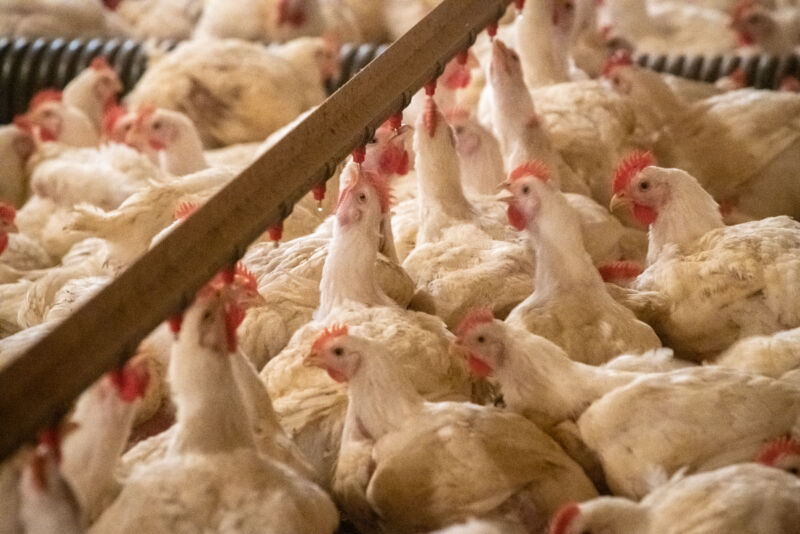
The highly pathogenic avian influenza H5N1 virus that spilled from wild birds into US dairy cows late last year may have recently seeped from a dairy farm in Colorado to a nearby poultry farm, where it then infected five workers tasked with culling the infected chickens
In a press briefing Tuesday, federal officials reported that four of the avian influenza cases have been confirmed by the Centers for Disease Control and Prevention, while the fifth remains a presumptive positive awaiting CDC confirmation.
All five people have shown mild illnesses, though they experienced variable symptoms. Some of the cases involved conjunctivitis, as was seen in other human cases linked to the H5N1 outbreak in dairy cows. Others in the cluster of five had respiratory and typical flu-like symptoms, including fever, chills, sore throat, runny nose, and cough. None of the five cases required hospitalization.
The virus infecting the five people is closely related to the virus infecting the chickens on the poultry farm, which, in turn, is closely related to virus seen in infected dairy herds and in other human cases that have been linked to the dairy outbreak. The affected poultry farm is in Colorado's northern county of Weld, which has also reported about two dozen outbreaks of avian influenza in dairy herds.
Dairy to poultry hypothesis
In one fell swoop, Colorado's poultry farm outbreak has more than doubled the number of human avian influenza cases linked to the dairy cow spillover, bringing the previous tally of four cases to nine. While officials have previously noted instances where it appeared that H5N1 on dairy farms had moved to nearby poultry farms, this appears to be the first time such spread has led to documented human infections.
The link between the poultry farm cases and neighboring dairy farms is still just a hypothesis, however, Nirav Shah, the principal deputy director at the CDC, emphasized to reporters Tuesday. "It is a hypothesis that needs and requires a full investigation. But that is a hypothesis at this point," he said of the link between the dairy farms and the poultry farm. So far, there is no direct evidence of a specific source of the poultry farm's infection, and the route of infection is also unclear.
Throughout the outbreak of H5N1 on dairy farms, officials have noted that the primary way the virus appears to spread to new farms is via the movement of cows, people, and machinery between those facilities. There remains no evidence of human-to-human transmission. But milk from infected cows has been found to be brimming with high levels of infectious virus, and milk-contaminated equipment is a prime suspect in the spread.
In the press briefing Tuesday, Eric Deeble, acting senior advisor for H5N1 response with the US Department of Agriculture, noted the poultry are very susceptible to avian influenza and are easily infected. "It does not take much to introduce this into a flock," Deeble said. The USDA is now working on a "trace-back" investigation on how the Colorado poultry farm was infected.
Searing spread
As for how the farm workers specifically became infected with the virus, health officials pointed to high temperatures that prevented workers from donning protective gear. The poultry farm is a commercial egg layer operation with around 1.8 million birds. Given the presence of bird flu on the premises, all 1.8 million birds need to be culled, aka "depopulated." This is being carried out using mobile carts with carbon dioxide gas chambers, a common culling method. Workers are tasked with placing the birds in the chambers, which only hold a few dozen birds at a time. In all, the method requires workers to have a high degree of contact with the infected birds, going from bird to bird and batch to batch with the carts.
Amid this grim task, temperatures in the area reached over 100° Fahrenheit, and massive industrial fans were turned on in the facility to try to cool things down. Between the heat and the fans, the approximately 160 people involved in the culling struggled to use personal protective equipment (PPE). The required PPE for the depopulation involves a full Tyvek suit, boots, gloves, goggles, and an N95 respirator.
"The difficulty with wearing all that gear in that kind of heat, you can imagine," said Julie Gauthier, executive director for field operations at the USDA's Animal and Plant Health Inspection Service (APHIS). The industrial fans blowing large amounts of air made it yet more difficult for workers to keep goggles and respirators on their faces, she said.
The CDC and the USDA are both involved in further investigations of the poultry farm outbreak. CDC's Shah noted that the team the agency deployed to Colorado included an industrial hygienist, who can work on strategies to prevent further transmission.
To date, at least 161 herds in 13 states have tested positive for avian influenza since the dairy outbreak was confirmed in March. Since January 2022, when US birds first tested positive for the H5N1 virus, 99 million birds in the US have been affected in 48 states, which involved 1,165 individual outbreaks.
reader comments
113